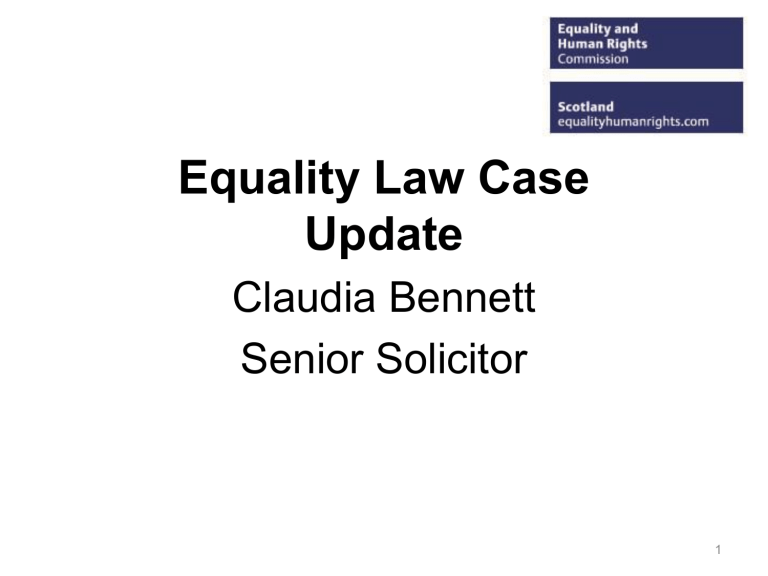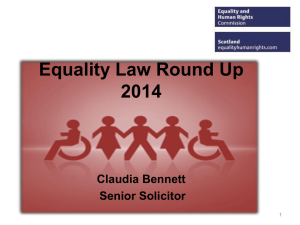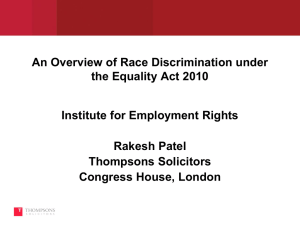Wilebore v Cable & Wireless Worldwide Services Ltd

Equality Law Case
Update
Claudia Bennett
Senior Solicitor
1
ET/ EAT Statistics
• Discrimination cases in 2012 - compensation awards
• Sex discrimination cases in 2012: highest number of discrimination awards
- Porter v Phaze Electrical Ltd
• Disability discrimination compensation awards: second highest number of awards
- Wilebore v Cable & Wireless Worldwide Services Ltd
Slide Number 2
What we will cover
• The Equality Act
• Protected characteristics
• Prohibited conduct
• Recent case law in relation to equality law
• The EHRC and its powers
• Our legal strategy
• Contact us
3
Protected Characteristics
• Age (s 5)
• Disability (s 6) slight change
• Gender reassignment (s 7) slight change
• Marriage and civil partnership (s 8)
• Pregnancy and maternity (s18)
• Race (s 9)
• Religion and belief (s 10)
• Sex (s 11)
• Sexual orientation (s 12)
4
Age (s.5)
• Where the Act refers to the protected characteristic of age it means a person belonging to a particular age group .
• An age group includes persons of the same age and people of a particular range of ages
• Only protected characteristic which allows direct discrimination to be justified.
5
Case Law
• Seldon v Clarkson Wright & Jakes
- justification defence
• Homer v Chief Constable of West Yorkshire Police
Slide Number 6
Disability (s.6)
• A person has a disability for the purposes of the
Act if he or she: —
- has a physical or mental impairment , and
- the impairment has a substantial and long-term adverse effect on his/her ability to carry out normal dayto-day activities.
• Mr Kevan Sweeney v Strathclyde Fire Board
(decided 2012)
• Walker v Sita Information Networking Computing
Ltd
• Wheeldon v Marstons plc
7
Race (s.9)
• Race includes — colour; nationality; ethnic or national origins.
• Also power to amend the definition to include caste (s.9 (5) (6) – caste now added to definition of race through amendment of ERRB (now Act).
• Begraj and anor v Heer Manak
Solicitors
8
Case Law
• Royal Bank of Scotland plc v Morris [2012] EqLR
406
• Redfearn v UK (2012) 47335/06
Slide Number 9
Religion or belief
(s.10)
• Covers any religion falling within Art 9 ECHR; must have clear structure and belief system
• Covers philosophical beliefs which meet particular criteria
• Includes a lack of belief/religion
• A ‘philosophical belief’ must not be incompatible with human dignity or conflict with fundamental rights of others [see EN 52]
10
Eweida and others v the UK
• Four cases complaining UK law failed to adequately protect their Art. 9 right
- 2 cases re wearing of cross taken together
- 2 cases complaining about sanctions imposed as a result of religions belief taken together
• ECHR Judgment January 2013
• Commission intervened under our s. 30 powers, with 13 others!
Slide Number 11
Impact of decision
• Confirms that a lack of state regulation of wearing of religious symbols does not indicate lack of adequate protection of Convention rights
• Lowers the test for interference with manifestation of religious belief, bringing it into line with other Convention rights = makes successful discrimination claim easier to bring
• Confirms importance given to positive obligations on public authorities to promote equality of opportunity and provide services in non-discriminatory way
Slide Number 12
Pregnancy and maternity (s.17 & 18)
• Protects a woman from discrimination during a protected period because of :
– The pregnancy
– Pregnancy-related illness
– Taking or seeking to take maternity leave
• New: includes protection from discrimination in education
• Ms Kate Cox v Money Station Resources LLP [2012]
13
Prohibited conduct
• Direct discrimination (s 13)
• Indirect discrimination (s 19)
• Harassment (s 26)
• Victimisation (s 27)
• Disability only:
• Discrimination arising from disability (s 15)
• Duty to make reasonable adjustments (ss 20
& 21)
14
Direct discrimination
A person (A) discriminates against another (B) if, because of a protected characteristic , A treats B less favourably than A treats or would treat others
• Preddy & Hall v Mr and Mrs Bull/ Black v Wilkinson
• Discrimination by association or perception included
• Direct discrimination can never be justified however age discrimination remains justifiable
15
Association and perception
Discrimination by association
• Less favourable treatment because associated with someone with a PC
• Does not need to be permanent
• Kulikauskas v Macduff Shellfish
UKEATS/0062/09/BI
Discrimination by perception
• Less favourable treatment because perceived to have a PC
Slide Number 16
Indirect discrimination
• A applies a provision, criterion or practice (PCP) to B
• A applies, or would apply, the PCP to persons with whom
B does not share the relevant protected characteristic
• the PCP puts, or would put, persons with whom B shares the characteristic at a particular disadvantage when compared with persons with whom B does not share the characteristic
• the PCP puts, or would put, B at that disadvantage and
• the PCP is not a proportionate means of achieving a legitimate aim.
• Cooper v House of Fraser (Stores) Ltd [2012]
EqLR 991
17
Harassment
• a person (A) harasses another (B) if A engages in unwanted conduct ‘related to a relevant protected characteristic’ which has the purpose or effect of violating B’s dignity, or creating an intimidating, hostile, degrading, humiliating or offensive environment for B.
• Case example: Cambers v Purcell Solicitors
• 3 rd party harassment – repealed
18
Victimisation
• ‘A person (A) victimises another person (B) if A subjects B to a detriment because (a) B does a protected act, or (b) A believes that B has done, or may do, a protected act.’
• Removes the need for the tribunal to construct an appropriate comparator.
• Bouabdillah v Commerzbank AG ET/2203106/12
• Woodhouse v West North West Homes Leeds Ltd.
• Rowstock Ltd and anor v Jessemay
19
Reasonable adjustments
• Where a disabled person is placed at a substantial disadvantage to non-disabled people, there is a duty to make changes to:
1. Provisions, criteria or practices
2. Physical features
3. And a duty to provide auxiliary aids and services (such as a hearing loop or a special computer service)
• Roberts v North west Ambulance Service [2012]
• Wade v Sheffield Hallam University [2013]
20
Discrimination arising from disability
• A person (A) discriminates against a disabled person (B) if A treats B unfavourably because of something arising in consequence of B’s disability
• Burt v New Forest District Council [2012]
• McGraw v London Ambulance Service NHS
Trust [2012]
21
EHRC strategic priorities for using litigation powers where the case would
• have a significant positive impact in terms of the application of the law or the policies and practices of an organisation, institution or sector
• have a positive public impact, securing greater understanding of rights and obligations under the equality enactments and/or human rights law
• address significant disadvantage in respect of one or more of the protected grounds and/or major abuse or denial of human rights
• challenge a policy or practice known to cause significant disadvantage
22
EHRC strategic priorities for using litigation powers.....
• is a cost effective method of achieving a desired outcome, taking into account the prospects of success
• clarifies an important point of law under the Equality Act
2010 or Human Rights Act
• will extend or strengthen protections and rights under the
Equality Act 2010 and, where it also applies, human rights law;
• will contribute substantially to other areas of the
Commission’s work
23
Further information
EHRC website information on Equality Act http://www.equalityhumanrights.com/legal-andpolicy/equality-act/
Law Society of Scotland http://www.lawscot.org.uk/about-us/equality--diversity
24
The Commission’s legal team in Scotland
• Strategic human rights and equality litigation www.equalityhumanrights.com/legal-andpolicy/strategic-human-rights-and-equality-litigation/
• Legal Team Bulletin: www.equalityhumanrights.com/scotland/legal-news-inscotland/equality-law-bulletin/
• Requests for assistance:
• legalrequestscotland@equalityhumanrights.com
Tel: Claudia Bennett 0141 228 5965
Email: Claudia.Bennett@equalityhumanrights.com
25







